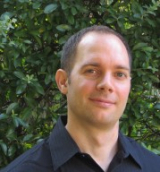
Aerosols, Clouds and Climate
Office: Burnside Hall 809
Tel.: (514) 398-7420
Fax.: (514) 398-6115
andreas.zuend [at] mcgill.ca (E-Mail)
Website
Research interests
My group works in the field of Atmospheric Chemistry and Physics with a focus on the chemical and microphysical processes governing the formation and transformations of atmospheric aerosols.
Atmospheric aerosols are tiny particles suspended in the air. Despite the small mass contribution of aerosol particles when compared to the major gaseous constituents of a volume of air, this particulate form of matter in the atmosphere is of fundamental importance for urban and regional air quality and the global climate system. Aerosols are among the least understood and quantified climate agents, affecting Earth’s radiation balance directly as well as indirectly via their crucial role in the formation of cloud droplets and influence on cloud microphysics. Part of the lack of knowledge is due to the complexity and variety of primary and secondary particle sources, the chemical composition, phases, and physical states of aerosols and the evolution of these properties during the lifetime of aerosols in the troposphere.
Current projects
Our research projects are motivated by the need to understand the chemical thermodynamics, reactions, and mass transfer kinetics of complex mixtures consisting of tens to thousands of oxidized organic compounds, water, and inorganic electrolytes that form and characterize the majority of aerosols in the troposphere. Improvements of the understanding and modeling of coupled processes between aerosols and the surrounding air lead to improvements in the interpretation of laboratory and field observations and predictions of air quality and aerosol-cloud-climate interactions.
We apply existing atmospheric chemical mechanisms, unique thermodynamic models and develop new numerical methods and system analysis tools for the characterization and prediction of aerosol particle composition, phases and phase transitions at environmental conditions. These tools allow us to improve the process-level understanding of atmospheric aerosol formation and evolution and enable the direct comparison to laboratory experiments and field studies performed by various collaborating groups. For example, in a recent project with an international team of collaborators, we developed a new approach to model the composition-dependent surface tension of aerosol particles serving as nuclei of cloud droplets. In that study, we designed an extension to our state-of-the-art liquid-liquid phase separation model, so that growing particle size and changes in composition and surface tension were considered in a realistic way. This has shed new light on the role of organic compounds and organic-rich phases in cloud droplet formation – and opened up new possibilities for addressing key questions about aerosol-cloud interactions in future research.
Current projects include the development of theory and reliable numerical algorithms for the calculation of liquid-liquid phase separation, liquid-solid equilibria, water content and acidity of complex chemical mixtures representing ambient and laboratory aerosols. We also work on coupled gas-particle partitioning schemes ranging from high to low complexity for applications in chemical box models (0-D) and implementation in 3-D atmospheric chemistry transport and climate models. Box models are, for example, applied to study the formation of so-called secondary organic aerosols from emissions and photochemical processing of volatile organic compounds above the Athabasca Oil Sands region in northern Alberta.
Ongoing work also focuses on the modeling of highly viscous phases of organic aerosols, their role in dynamic mass transfer in the atmosphere, and on how we can predict such particle properties in a feasible way.
Find out more about our current research projects by visiting the group website or by andreas.zuend [at] mcgill.ca (contacting me directly).
Recent Publications
-
Ovadnevaite, J., Zuend, A., Laaksonen, A., Sanchez, K. J., Roberts, G., Ceburnis, D., Decesari, S., Rinaldi, M., Hodas, N., Facchini, M. C., Seinfeld, J. H., and O’ Dowd, C.: Surface tension prevails over solute effect in organic-influenced cloud droplet activation, Nature, 546, 637–641, doi:10.1038/nature22806, 2017.
-
Rastak, N., Pajunoja, A., Acosta Navarro, J. C., Ma, J., Song, M., Partridge, D. G., Kirkevag, A., Leong, Y., Hu, W. W., Taylor, N. F., Lambe, A., Cerully, K., Bougiatioti, A., Liu, P., Krejci, R., Petäjä, T., Percival, C., Davidovits, P., Worsnop, D. R., Ekman, A. M. L., Nenes, A., Martin, S., Jimenez, J. L., Collins, D. R., Topping, D. O., Bertram, A. K., Zuend, A., Virtanen, A., and Riipinen, I.: Microphysical explanation of the RH-dependent water-affinity of biogenic organic aerosol and its importance for climate, Geophys. Res. Lett., doi:10.1002/2017GL073056, 2017.
-
Chim, M. M., Cheng, C. T., Davies, J. F., Berkemeier, T., Shiraiwa, M., Zuend, A., and Chan, M. N.: Compositional evolution of particle-phase reaction products and water in the heterogeneous OH oxidation of model aqueous organic aerosols, Atmos. Chem. Phys., 17, 14415–14431, doi:10.5194/acp-17-14415-2017, 2017
For a complete list, please visit the publication list on the Zuend Group website.